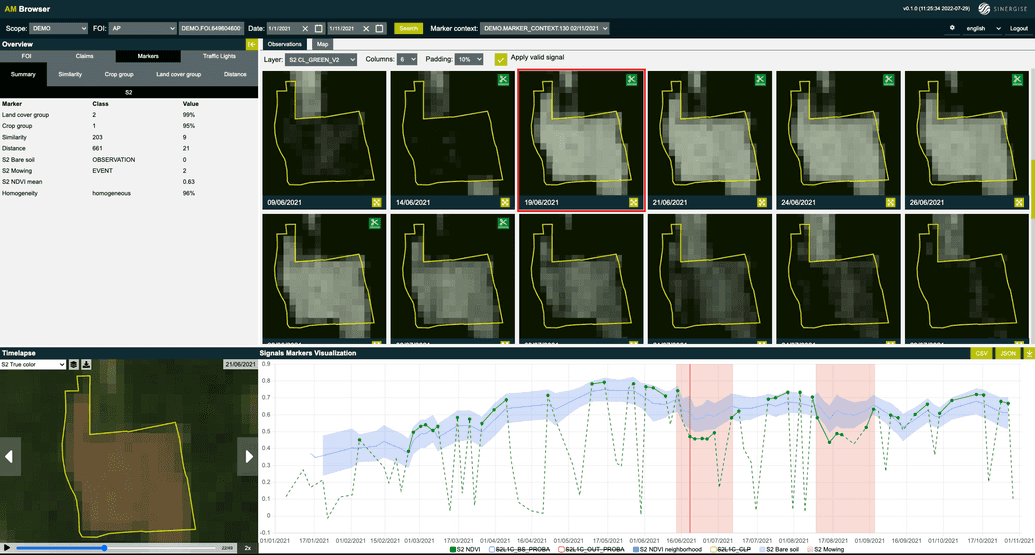Mowing Marker
Basic info
Mowing marker identifies all observations where mowing events lead to a drop and subsequent recovery in the time series of vegetation index signal, such as Normalized Difference Vegetation Index (NDVI). Algorithm works on any signal where mowing events introduce some sort of a change.
Further info
Mowing causes vegetation index like NDVI to drop as it can be seen in the Figure below showing NDVI time-series around a labeled mowing event averaged over close to ten thousand events. For producing this image NDVI time series of each FOI was shifted in time so that observation that has minimal value of NDVI during the mowing event is at day zero. Figure shows that NDVI drops in average for around 0.15 and that it takes around 20 days in average for NDVI to recover to values prior to the mowing event. Mowing marker algorithm searches for such drops and recoveries in time series of NDVI.
Two versions of the marker are available:
- FOI-level marker: mowing detections is executed on a time series of a vegetation index, such as NDVI, aggregated over all pixels within a FOI.
- Pixel-level marker: mowing detection algorithm is executed on a time-series of a vegetation index, such as NDVI, of each pixel within a FOI. Pixel-level mowing marker results are then aggregated over all pixels within a FOI into quantities like area of FOI that has been mowed at least once, largest connected area that has been mowed, etc. Such FOI-level information can later on be used in the decision making process.
FOIs with a detected FOI-level mowing event
- FOI = 6496046001 is declared as permanent meadow. Mowing marker detected two mowing events indicated with two vertical blue bands in the Signal component of the shown Browser App Screenshot. True color Sentinel-2 images from the time period around the detected mowing event confirm that the FOI has really been mowed.
FOIs with a detected pixel-level mowing event
FOI = 6524519001 is declared as permanent meadow. FOI-level mowing event finds no events. Pixel-level mowing marker finds that east part of the FOI was mowed. Visual inspection shows that the west part of the FOI was also mowed during second partial mowing event towards end of the season.
FOIs without a detected mowing event
There can be many reasons why no mowing event is detected. For example:
- A FOI is not mowed but it is grazed. Grazing doesn't introduce so large sudden drops in the time-series of vegetation index so grazing is typically difficult to detect.
- There are not enough valid observations available around the time the mowing event occurred. If Sentinel-2 observations are not available for a longer period of time due to cloud cover, then it can happen that mowing events can't be detected with Sentinel-2. When this happens we can use alternative sources, such as Planet Fusion or Sentinel-1 to make an independent check if area of a FOI was mowed or not.
- An observation where evidence of mowing event are seen but partially occlude with a cloud or cloud shadow can be identified as invalid. Mowing marker algorithm can thus miss to detect such an event, however an expert can correctly interpret the imagery and confirm that a FOI has been mowed.
- NDVI drop or recovery is just below the threshold applied by the algorithm. An expert can correctly interpret the imagery and confirm that a FOI has been mowed.
Signal sources
We have successfully applied mowing marker on different signal sources, such as Sentinel-2 L1C and L2A, PlanetScope, Planet Fusion, and Sentinel-1 coherence. Algorithm works with many different signals, such as NDVI, Leaf Area Index, etc.

